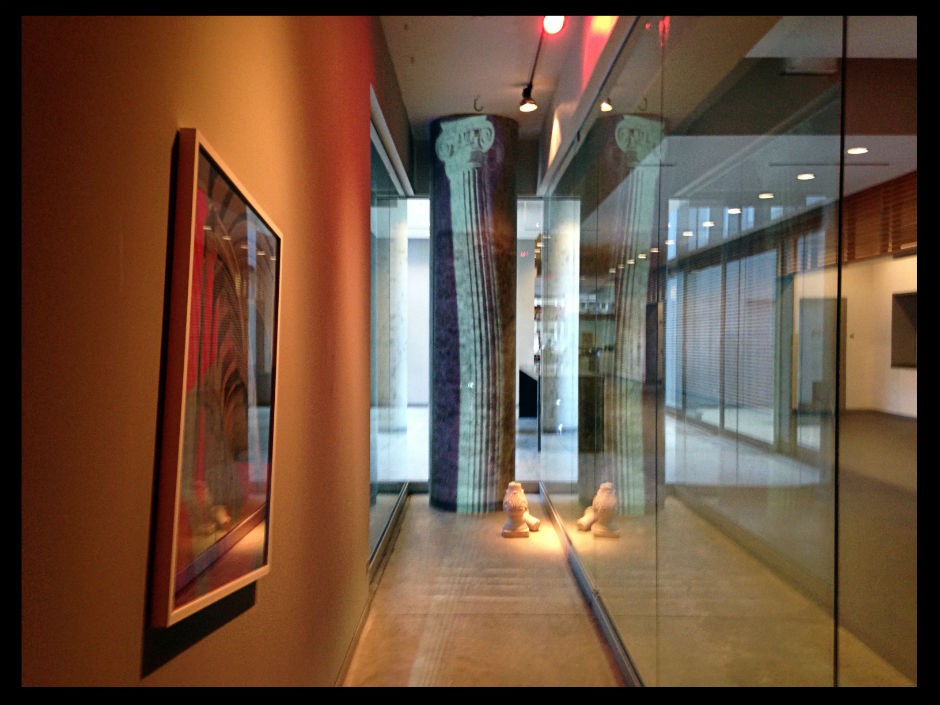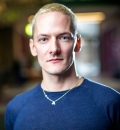Matthew-Robin Nye is a conceptual artist and Joseph-Armand Bombardier PhD student at the Centre for Interdisciplinary Studies in Society and Culture. Nye’s research spans the fields of contemporary art, process philosophy and performance theory to look at how to create a ‘queer utopic space’ or a concept of ‘wildness’. He is a founding member of the Curatorial Research-Creation Collective at the Milieux Institute, a member of the Senselab, and the Institute for Urban Futures.
Blog post
Making contact: forging connections in a world of networking
 An installation view of Visitations at the FOFA Gallery in 2015 | Photo by Matthew-Robin Nye
An installation view of Visitations at the FOFA Gallery in 2015 | Photo by Matthew-Robin Nye
I am truly grateful that the School of Graduate Studies has selected me to represent doctoral studies at Concordia. In doing so, the School of Graduate Studies has signalled its support for my work, its belief in my ability to communicate its importance to a broader public, and that it shares in my conviction that concrete outcomes — or methods that know themselves in advance — do not necessarily measure the product of speculative practice.
The Concordia Public Scholars Program offers me the opportunity to disseminate my research and artistic practice, which, for the length of my studies at Concordia, are following a ‘research-creation’ methodology — an interdisciplinary project characterized more by the unexpected interaction between discrete fields of study, more than stable outcomes.
As an artist and cultural producer, my work is concerned intellectually and creatively with the world around me, in theorizing and producing better worlds. The Public Scholars Program prompts me to participate in conversations outside of personal and academic networks, and the bounds of the university itself.
As someone for whom the spotlight feels uncomfortably bright, the position of Public Scholar challenges me to present myself in a manner that I characterize as ‘frontal.’ For me, being frontal is the presentation of a stable face, a mode of being that is public, readable. To be frontal is to enact a performance principle of a dominant cultural logic — to be decipherable by enacting the social codes which govern our behaviour.
Examples of a performance principle might be sustained eye contact (but not for too long), a firm handshake (but not too tight or limp).
To be ‘frontal,’ at its worst, is to simplify the complexity and texture of life’s possibilities — to become decipherable, limited in the meaning that you can produce within these codices. To hide the (often messy) mechanics of thinking and study in favour of a unified performance of productivity, replete with narratives of excellence and success.
Contact
In his book Times Square Red, Times Square Blue, the author and theorist Samuel R. Delany proposes two modes of sociality: ‘(interclass) contact’ and ‘networking.’ For Delany, ‘networking’ situations are those that are intra-class, facilitated by commerce, institutional match-making, and even government and social policy. These generally well-meaning engagements are flawed, he argues, because they categorize individuals by commonality, foreclosing the possibility of contact outside of social status from one and other.
Delany suggests that ‘networking’ situations rarely produce meaningful relationships or opportunities for engagement outside of their prescriptive spheres. He uses the example of academic or industry conferences framed as ‘networking events,’ stating that while great for learning, these events often fall short of attendees’ expectations for professional advancement. If the attendee’s objective is career mobility or a publishing deal, the chances for success are slim, due to enhanced competition from a chorus of same-minded individuals.
On the other hand, ‘contact’ situations are those that are un-mediated by social codes, economy or institution. ‘Contact’ situations are not inherently competitive, they are collective, fortuitous, generous.
They’re not prescriptive, have no objective — you don’t walk to the corner store with the hope of signing a book deal, (even if it would be nice!) but walking to the corner store in a dense neighbourhood might actually afford the possibility of meeting someone who could have a radical impact on the course of your life.
Contact situations happen in urban environments, in quotidian movements, in spaces of sexuality and sexual exploration — generally, in places unmediated by formal institution, finance or a performance principle. Contact might be facilitated by desire, but it is desire that is not necessarily governed by the drive to personal gain, in the form of economic, social or academic success.
Public space
“Queerness, as I am describing it here, is more than just sexuality. It is this great refusal of a performance principle that allows the human to feel and know not only our work and our pleasure but also our selves and others” – José Esteban Muñoz, Cruising Utopia
In its ideal form, the university is a ‘public space.’ It is an intense site of creativity, research, thinking and innovation. Its work is messy by imperative, and vital — not only in its importance to the discourses that it is a part of, but in the contribution to our world of the lively texture of process, thought, politics and becomings.
This messiness and texture is, for me, joy. Experimentation, speculative research, collaboration and imagination — becoming-with — outshine and outstrip the performance principle, and its coordinate, ‘networking,’ every day.
There is a lot of work to do in keeping the university public, and reconstituting publics that it has lost, or never had. In actuality, from the outside, the university can seem opaque, intimidating. Large institutions have immense difficulty making space for the differently bodied, neurodiverse, indigenous and racialized, though I believe that they try, and in the case of Concordia, valiantly.
What if the Public Scholars Program — and its participants — facilitated ‘contact’ (without goals, without end) rather than ‘networking?’ What if the object of a Public Scholar was not to present a face to a public, but to make publics of the Institution, as a site of contact that encourages new worlds?
Here, in my first blog post, I’m inviting contact as a supplement to networking. Can I manage the mantle of the institutional spotlight when, for me, being ‘frontal’ comes with some psychological wear?
Samuel Delany says that the informal institutions that facilitate contact are always under siege, ‘battered again and again until they are destroyed,’ and that ‘new institutions must always be conceived and set in place to take over’ (111). Let’s meet in the street. On the dancefloor. On the metro. The bathhouse. In the market. Over direct message. In Kanehsata:ke. At the Bill 21 protest. In the future, now.
1. Delany, Samuel R. Times Square Red, Times Square Blue. 1999.
2. Muñoz, José Esteban. Cruising Utopia: The Then and There of Queer Futurity. New York University Press, 2009.
About the author


